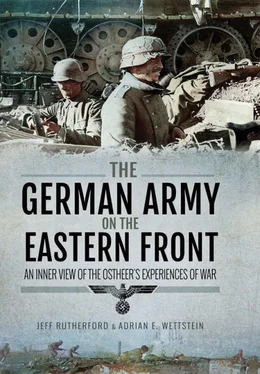It is considered necessary to equip at least the battalion staffs, the [regimental] engineer and bicycle platoons, and the machine gun companies with the SMG 44. This is based on the experiences of the last battles, in which regimental and battalion staffs and machine gun companies were often involved in close combat, as were sometimes the crew of the heavy mortars and infantry guns, and had to be deployed for counterthrusts to eliminate penetrations due to lack of other reserves.
a) Due to considerations of the danger of gangs, the possibility of surprise attacks in the rear area, and of sudden breakthroughs, it is desired that all soldiers that, according to the table of organization, are equipped with the rifle are equipped with SMG 44, with the exception of snipers and rifle grenade. The baggage trains then would also have a greater self-protection.
b) When applying a sharp standard, the equipping of the baggage train with the SMG 44 could be omitted.
c) When applying an especially sharp standard on the equipping with the SMG 44, the crew of heavy mortars and infantry guns (without forward observer personnel) [could] also [be] omitted. […]
When the increase in combat power provided by this weapon is considered, it seems surprising that the German army took so long to introduce it. The assault rifle gave the German infantry a massive superiority in tactical encounters, as it combined firepower and mobility. For example, the addition of this weapon solved the problem that plagued German Panzer units in 1943 and 1944, namely massive ATG fronts. It also compensated for the German soldiers’ numerical inferiority, a regular condition on the Eastern front. The introduction of this weapon did not come about in one sweep, and it actually never appeared in substantial numbers on the Eastern front. As there were never enough assault rifles, it was discussed which soldiers should receive it for the greatest effect, as the source above indicates. One has to add that for most German units on the Eastern front in September 1944, the issue of partisan warfare had disappeared as the frontline was rapidly reaching German and allied territory.
III) Training
Has the concentration of the light machine gun, the SMG, the snipers and the rifle grenade riflemen had a favourable effect in regard to training?
Until now, no difficulties have occurred in the training. But it is already necessary to train and equip the replacements in the Grenadier replacement and training battalions. The concentration of the light machine gun, the SMG, snipers and rifle grenade riflemen substantially simplify the training.
IV) Fire discipline
1) Was fire discipline maintained in such way that ammunition consumption had a favourable ratio to the necessities of the combat even after the loss of leaders and sub-leaders and in difficult combat situations?
With regular training, especially with replacements already [trained] at the attached replacement unit, there was no higher ammunition consumption. The last large combat actions have shown that it was possible to maintain fire discipline so that ammunition consumption stood in normal relation to the necessities of the combat even after loss of leaders and sub-leaders and in difficult combat actions.
What is the ratio between the ammunition consumption of the Grenadier company with experimental organization in comparison to a Grenadier company with the previous organization?
Ammunition consumption had not increased through the arming [with new weapons]. The now higher consumption rate of the SMG is fully compensated for by the previous higher consumption rate of machine gun ammunition.
In the end, field tests and later actual combat use proved those who feared a mushrooming ammunition consumption completely wrong. The advantages of the weapon, including the higher concentration of fire that quickly broke enemy resistance, the better chance of hitting the target due to the easier targeting process, and finally the above-mentioned lower ammunition consumption of machine guns caused this somewhat paradoxical result. Another virtue of the gun’s use was that firepower was less concentrated on individual soldiers, which gave smaller units a higher sustainability in a fire fight.
V) Weapon-technological questions
Larger defects of the SMG did not appear.
The following smaller failures are pointed out:
[…]
b) The SMG 44 is often tilted due to the exceptionally high front-sight base
c) The gas lever was partially jammed with brand-new SMG. Therefore the tightening was no longer perfect.
d) On various occasions the barrel protection broke from the holding notching through falls, pushes and so on.
[…]
f) The butt holding bolt is too loose. When it’s lost, the weapon is non-operational.
g) The jamming of feeding cartridges and the expulsion of cases often occurs with new weapons. Good oiling largely eliminates these jams. After firing around 500 cartridges, the jams are eliminated by the loosening of the sliding parts.
h) Other jamming did not occur. Merely when cramming the magazine with 30 rounds were light jams produced with the feeding of cartridges. Therefore the magazines must be filled with only 25 rounds.
In order to avoid an early rusting, the black finishing of the weapon must be better. It is advisable to produce the magazine pouches of a basic soldier’s material so that they have a longer life period.
VI) Ammunition supply […]
1) What was the effect of the introduction of a new type of ammunition on the infantry?
The introduction of a new type of ammunition had no particular consequences.
As previously mentioned, one of the main fears of introducing the weapon was the burden on the supply system caused by a new type of ammunition. But as that report (and most others on the supply question) illustrates, it was not an issue.
What seems striking is how many technical details required improvement. But one should not be misled by the catalogue of complaints. A look at comparable files on proven weapons in service for years or even decades had similar lists of technical issues. The German military apparatus placed great value on the frontline’s suggestions for improvement, and those often became something like a ‘wish list’ with any and all possible details mentioned. While this helped to continually improve weapons and equipment, it put an enormous burden on the military bureaucracy’s decision-making process: which improvements were necessary and which were merely desired. Furthermore, due to so many changes in the details of a weapon system, its production numbers were negatively affected. A well-known case is the Junkers Ju 88 bomber which went through no less than 58,000 modifications during its period of production. [18]
The report shows all the questions that arose with a new system and highlights the importance placed on a full range of issues, as opposed to simple technical questions. Often tactical and organizational adaptations were needed to make a new system effective. Questions of training, command and supply also arose. The evaluation reports from the combat tests raised yet another issue: there were often contradictory observations and experiences taken from the tests. It was then up to the interpreting agency to decide what to do with the results. Even here, there were problems; while extensive combat tests may seem logical, they could compromise secrecy of a new weapon and allow the enemy to take defensive measures. As seen with the Assault Rifle 44, actual testing of the weapon was a time-consuming process, which was often not possible under wartime conditions. This resulted in numerous weapons going into action before they were fully operational. The Panther tank, which later evolved into Germany’s best tank, was a complete disaster in its first use during Operation Citadel in summer 1943. Technical problems, as well as faulty organization – the Panther units were oversized and therefore very difficult to command – plagued the initial use of these tanks. [19]
Читать дальше






![John Stieber - Against the Odds - Survival on the Russian Front 1944-1945 [2nd Edition]](/books/405234/john-stieber-against-the-odds-survival-on-the-russian-front-1944-1945-2nd-edition-thumb.webp)





